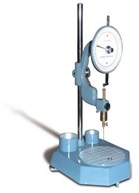
A Standard Penetrometer, commonly known as the Standard Penetration Test (SPT), is a geotechnical investigation tool used to assess the density or relative density of granular soils, as well as the consistency of some clays. It is one of the most widely used in-situ testing methods for subsurface exploration.
- Procedure:
- A borehole is drilled to the desired depth.
- A split-spoon sampler (a hollow tube with a cutting edge) is attached to the bottom of a drill string and driven into the soil by a hammer.
- The hammer, typically weighing 63.5 kg (140 lb), is dropped from a height of 760 mm (30 inches).
- The number of blows required to drive the sampler 150 mm (6 inches) into the soil is recorded.
- The test is repeated for two additional 150 mm increments, and the total number of blows required for the last 300 mm (12 inches) is referred to as the “SPT N-value” or “N-count.”
- Interpretation:
- The SPT N-value provides an indication of the soil’s relative density or consistency. Higher N-values generally indicate denser or more compact soil.
- The N-value can also be used to estimate other soil properties, such as shear strength and bearing capacity, though corrections are often applied to account for factors like overburden pressure, equipment type, and energy efficiency of the hammer.
- Determining the bearing capacity of foundations.
- Evaluating liquefaction potential in seismic regions.
- Assessing soil stratigraphy for construction projects.
- Providing data for foundation design, including the depth and type of foundations required.
The SPT is valued for its simplicity, cost-effectiveness, and ability to provide direct measurements from the field, making it a standard in geotechnical engineering practices worldwide.